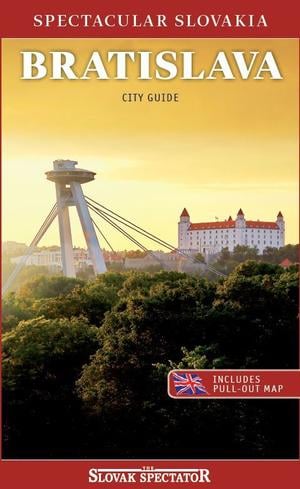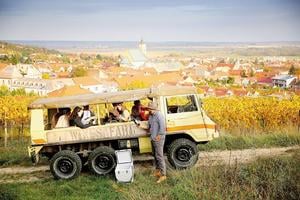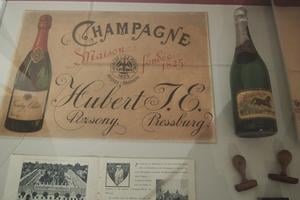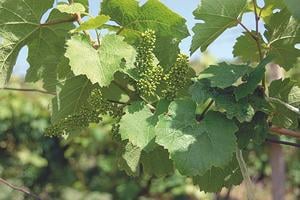You have access to this premium content thanks to ING Hubs Slovakia, the expert hub of global banking.
This article was published in the latest edition of our Bratislava City Guide, which can be obtained from our online shop with Spectacular Slovakia travel guides.
 Lost in Bratislava? Impossible with this City Guide! (source: Spectacular Slovakia)
Lost in Bratislava? Impossible with this City Guide! (source: Spectacular Slovakia)
There’s a certain irony in the fact that Slovakia is considered among the so-called “new” wine-producing countries of the world. Winemaking in these parts has a proven history dating back to the 6th–7th centuries BC. Yet the comparatively low awareness of Slovak wines abroad is largely owing to the patterns of its consumption: hardly any makes it beyond the keen wine-drinkers within Slovakia’s borders. This means that if you want to try Slovak wine – and you should – you’ll need to come to the country to do so.
The reputation of Slovak wines has improved significantly in recent years, as indicated by its results in international competitions. Slovakia produces about 380,000 hectolitres (hl) of wine (i.e. 38 million litres), of which only about 40,000 hl is exported. White wines make up 66 percent of local production.
“We in Slovakia cannot afford to produce cheap, low-quality wines,” said Jaroslava Kaňúchová-Pátková, executive director of the Grape and Wine Producers of Slovakia (ZVHV). “In this [area], bulk producers beat us.”
City centre: Wine shops & Wine-tasting
Museum of Viticulture + Slovak National Collection of Wines: www.salonvin.sk
Vínimka: www.vinimka.sk
Vinotéka Trunk: www.facebook.com
Grand Cru wine gallery: www.grandcruwinegallery.com
Wine Not!?: www.facebook.com
Hotel Matyšák – wine restaurant: www.hotelmatysak.sk
Vinotéka pri Modrom kostolíku: www.vinotekamodrykostolik.sk
Kaňúchová-Pátková highlights the importance of new varieties among Slovak wine producers, which are specifically cultivated to exploit the full potential of Slovakia’s climate and soil. The result is a selection of wines that cannot be made anywhere else.
“You can taste Chardonnay almost everywhere in the world, but the Devín, Dunaj, and Mília varieties you can only taste here in Slovakia,” said Kaňúchová- Pátková. “This is how we can establish ourselves in the world. Devín and Dunaj are wines that are also harvesting success in world competitions.”
White Devín and blue Dunaj are the most popular new Slovak grape varieties among Slovak winegrowers.
The white Devín grape is a cross between the Tramín červený (Gewürztraminer) and Veltlínske červenobiele varieties. It produces a green-yellow wine with a moderately spicy aroma, leaning towards Muscat. This variety, crossed with Dorota Pospíšilová and Ondrej Korpás in 1958 in the Wine Research Institute in Bratislava, produces dry wines as well as naturally sweet wines.
The Dunaj variety was created by Pospíšilová in 1958, when she first crossed Muškát Bouchet with Oporto and then with Svätovavrinecké (St. Laurent). With its early ripening it is a very suitable variety for Slovak climatic conditions.
City centre: Wine bars
Viecha pod hradom: ww.viecha.com
Viecha Stará tržnica: ww.viecha.com
Viecha modranských vinárov: ww.viecha.com
As the capital of the country, it is only fitting that Bratislava’s vineyards also made the city the first significant viticultural and wine-making town in what is now Slovakia. However, the commercial prosperity of the modern city, and pressure from developers, has meant the acreage of vineyards in Bratislava has decreased over the years.
Bratislava and its surroundings belong to the Small Carpathian wine-growing area and the region’s changing terrains mean that each of its wine-growing districts is known for a different variety. In Rača, it is Blaufränkisch or Frankovka modrá; in Vajnory, it is the white Leanka; and Devín is best known for its currant wine.
Currant Devín
Currant wine almost completely disappeared from Devín in the 1990s, but Augustín Mrázik, a local who is an IT expert by profession, set out to restore its story. Thanks to his and other local producers’ efforts, visitors can still taste the local specialty.
Outside of the city centre: Wine-tasting
OZ Terroir Rača : www.terroirraca.sk
Villa Vino Rača: www.villavinoraca.sk
Vinohradníctvo a vinárstvo Miloš Máťuš: www.vinomatus.sk
Víno Rakyta: www.vinorakyta.sk
Vinárstvo Chvostek: www.chvostek.sk
Račianska vinotéka: www.facebook.com
Vinárstvo Hulanský: www.vinohulansky.sk
Vinárstvo Adams Family: www.vinoraca.sk
Víno Vajnory: www.vinovajnory.sk
Víno Vladár a syn: www.vinohrady-vladar.sk
BRATIA ČÍČKOVCI vinohradníctvo a vinárstvo:
Komunitná záhrada Pionierska
THEBENER - Devínsky ríbezlák: www.thebener.com
Baba Wine Shop :
Vinárstvo Cenký : www.vinocenky.sk
“Currant wine has always belonged to Devín,” said Mrázik. “I could not imagine that currant wine would disappear from Devín. Thus, after I failed to motivate my wine-making friends enough to salvage the tradition, I started its production in 2007.”
While traditional currant wine is sweet, Mrázik as well as other currant wine producers nowadays produce a whole scale of currant wines: traditional semi-sweet from red and black currants, but also barrique currant wine, wine exclusively from red, black or white currants as well as medium dry and dry wine and other specialities like fortified wine. That Mrázik chose the right path is proven by medals he has been collecting at international competitions.The best opportunity to taste all kinds of currant wine, as well as other specialities made from currants, is to visit the annual festival Ríbezľový Devín (Currant Devín) held in Devín in July.
Enchanted by Frankovka
Frankovka has a royal seal of approval, bestowed by Empress Maria Theresa in 1767. She was reputedly enchanted by its taste and quality and deemed it suitable to be served at the imperial table. Two centuries later, scientists were able to give her opinion some additional credence when they discovered resveratrol, an ingredient believed to have benefits for the heart, in Frankovka.
It‘s the sunny location as well as the soil composition of the vineyards in Rača to which the local Frankovka owes its unmistakable taste. This belief is echoed by Jozef Mórik, an enthusiastic grape grower and wine maker who revitalised with his four friends one of Rača’s oldest vineyards, Tále.
“It was our dream,” said Mórik. Frankovka, called the lightest red wine full of concentrated bouquets of fruit and berries, with a harmonic and round taste, enchanted him with its taste and history, he admits.
Wine events
June-September: Račanská lokálka (tourist wine train); FB: tour4u.sk
May: Festival of Frankovka in Bratislava; Wine tasting of Blaufränkisch or Frankovka modrá traditional variety of wine in Bratislava region; www.visitbratislava.com
May, November: Day of open cellars Winemakers in the Small Carpathian region open their doors several times a year for a day and visitors can taste anything they want for a fee; www.mvc.sk
September: Currant Devín; Tasting of traditional currant Devín wine made from red and black currants
Vintage in several towns of the region (Bratislava-Rača, Modra, Pezinok, Svätý Jur) offers the opportunity to taste burčiak (young wine or immature wine typical for the region)
The 2.5-hectare Tále is a vineyard where wine lovers can stop while wandering along the Račanský Vinohradnícky Chodník (Rača Vineyard Path). An alternative to walking is taking the Prešporáčik tourist train that runs on the new line Račanská lokálka along Račanský Vinohradnícky Chodník during the summer season. Every Friday, it takes passengers through the streets of old Rača and its vineyards, and also stops at the cellars of local winemakers.
Just next to Rača is another historical wine-producing village, Vajnory, now part of Bratislava. Here, the best place to taste local wines is the newly established wine shop of the local farm PD Vajnory on Hospodárska Street. It offers 26 kinds of wine produced exclusively from grapes grown in their vineyards totalling 30 hectares.
Those who want taste or buy the best wines from all of Slovakia should head to the Slovak National Collection of Wine in Apponyi’s Palace on Bratislava’s Main Square. They will find here a collection of the 100 best wines from Slovakia selected each year. Booking is recommended.
Other popular places in the centre of Bratislava are wineshops (vinotéka) with degustation programmes as well as wine bars (viecha) where you can have bottled wine or have a glass tanked from barrels with wine of good quality and affordable prices.
Festivals
The grape harvest festival (vinobranie) season in the region of Bratislava starts in late August and lasts until mid November. Burčiak, a slightly alcoholic and sparkling drink, is a regional specialty offered only in Slovakia, the Czech Republic and Austria. In addition to festivals, you can taste it during autumn in wine bars in the city.
Burčiak’s sweet, natural, intoxicating flavor lures drinkers into danger. The cumulative effect of several drinks, a.k.a. “the burčiak curse,” creeps up on them later after several glasses of the stuff. Although its average alcohol content of 5% is only half that of mature wine, burčiak continues to ferment just as merrily inside the drinker’s stomach. The continued fermentation, combined with a “bubbly-champagne” effect, gives burčiak its infamous one-two punch. According to Slovak legend, every man should replace his blood every year with two liters of burčiak.
“I like to go to wine harvest festivals not only to taste burčiak, but also to talk with wine makers and wine growers about wine and the current wine season, or just to meet with friends which, especially now, when everything is affected by the coronavirus pandemic, I highly appreciate,” said Renáta Novotná, a regular visitor of wine harvest festivals.
Taking a wine route
Many Slovak wine experts insist that wine should be tasted where it is produced, and a lot of wine makers have thrown open their cellars to allow visitors the opportunity to do just that. Numerous ancient cellars or brand new premises are open throughout the year, many clustered along the so-called “wine roads” that snake the country.
The Small Carpathian Wine Route (MVC) is the oldest example in Slovakia. It hosts several popular events throughout the year, including the annual Day of Open Wine Cellars in autumn and the annual St Urban’s Day of Open Cellars in spring. On both occasions, many of the top wine producers open up for visitors to taste young and vintage wines.
The route itself is a string of more than 30 towns and villages along the east side of the Small Carpathians, of which Pezinok, Modra and Svätý Jur are the best known. In Pezinok, visitors can admire as many as 43 wine presses, the biggest collection in central Europe, in the Malokarpatské múzeum (Small Carpathian Museum) or head to the recently reconstructed chateau Šimák with a winery located in the 800-year old cellars underneath.
In Modra, a must-see place is the wine park Elesko. It contains a restaurant and gallery, where visitors can not only see wine being produced but also mix their own cuvée.
“It will be exceptional because it will contain your story,” promises the winery.




